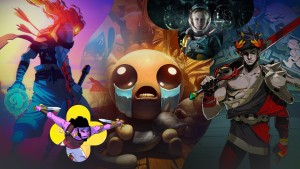Please support Game Informer. Print magazine subscriptions are less than $2 per issue
Doom Clone Troopers – The Story Behind Star Wars: Dark Forces
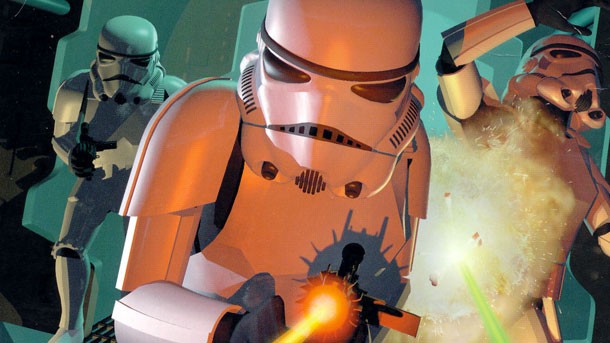
This is an expanded version of the Classic GI article that ran in issue #263 of Game Informer.
Every kid who grew up loving Star Wars dreamed about piloting an X-Wing or firing a blaster at a group of charging Stormtroopers. Many Star Wars games of the '80s and '90s put players in the cockpit, but the feeling of having your boots on the ground in George Lucas' legendary world remained elusive. All that changed 20 years ago on February 28, 1995, when a group of LucasArts developers combined their love for the sci-fi franchise with id Software's genre-defining first-person shooter formula.
LucasArts enjoyed its heyday in the '90s, when the studio put out legendary adventure games like Day of the Tentacle and Indiana Jones: The Fate of Atlantis. The team also found its footing in the Star Wars franchise, including unforgettable space-flight games like X-Wing and TIE Fighter. Daron Stinnett, developer and director of Dark Forces, worked on flight simulators at Spectrum Holobyte before joining LucasArts. He points to X-Wing as the game that revitalized his passion for the franchise and the first-person perspective.
"In the mid to late '80s and '90s, I kind of lost touch with [Star Wars]," Stinnett says. "It honestly wasn't something that I thought about until I sat down in the cockpit and flew an X-Wing [in Star Wars: X-Wing]. I was so floored and it all came back. I just marveled at how amazing it was that 15 years earlier I had sat in a theater and watched someone fly an X-Wing in a big battle and here I was flying and being... in that X-Wing."
When the Dark Forces development team wasn't busy brainstorming ideas for the game, the creators were blasting one another into bloody pulps in Doom deathmatches. Stinnett says his initial inspiration to make a first-person Star Wars game came from Wolfenstein 3D, but Doom's marathon multiplayer sessions heavily influenced the design of Dark Forces.
In fact, so many developers were inspired by id Software's demonic PC blockbuster that for a period of time before the genre was labeled, first-person shooters were commonly referred to as "Doom clones." I asked Stinnett if being labeled a "Doom clone" by some in the '90s bothered him.
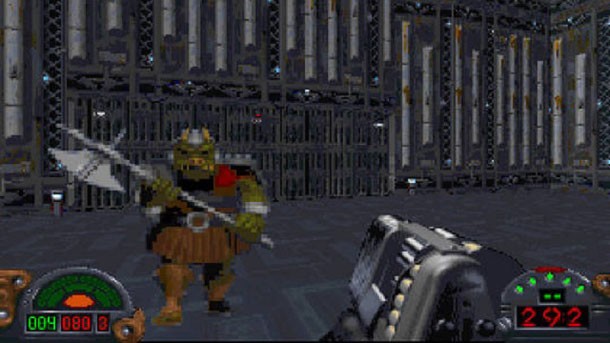
"It didn't, because the Doom gameplay and the way the worlds were built were defined by the technology at the time," he says. "There wasn't any other way to render worlds. If people called Dark Forces a "Doom clone," they might have because of the similar way the worlds are rendered. In fact, we did things a little differently and it enabled us to do a lot more than Doom could do."
Doom mods swapping out imps with Imperial soldiers were popular in the early '90s, but LucasArts was committed to make an authentic Star Wars experience.
The game stars Kyle Katarn, a politically agnostic mercenary hired by the Rebel Alliance who eventually becomes a devotee of the movement. Stinnett says the story, characters, and art style were all concocted by former LucasArts artist Justin Chin. The first mission tasks players with storming an Imperial base to steal the plans for the Death Star. Katarn's trusty blaster sways on screen as he drops in on a group of Imperial officers standing at their black and gray consoles with an array of colored buttons. A MIDI remix of John Williams' classic score sets the tone as red and green blaster fire is exchanged. The first mission of Dark Forces was a transformative experience for any fan of the series, and video games in general.
The Jedi Engine – inspired by id's Doom Engine and created by LucasArts – injected a new degree of level design into the first-person genre. Unlike Doom's sprawling labyrinths, the Jedi Engine allowed developers to stack rooms on top of each other to create more complex environments. But before the magic could happen, Stinnett needed people who understood how to create 3D spaces.
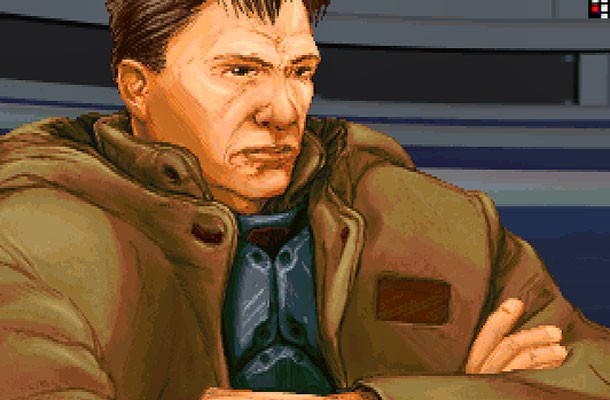
Dark Force's mercenary protagonist, Kyle Katarn
Unfortunately, LucasArts' designers were primarily skilled in creating 2D games or drawing sets for adventure games. Stinnett needed to look elsewhere for the people who would help build the Star Wars universe.
"I realized pretty quickly that architects are the people that know how to make environments," Stinnett says. "So I went to the University of Berkeley and connected with the architecture school over there and found a couple of guys who were also big gamers and convinced them to come work for LucasArts and join the Dark Forces team as architects and level designers."
One of those architecture students was Ingar Shu, who says his career path changed thanks to a chance meeting between his college professor and Stinnett as they were waiting in line for a movie. Stinnett talked with Shu's professor about needing designers who understood level design, and the teacher brought the potential opportunity to Shu. "I actually dropped out of college at that point to take a job at LucasArts," Shu says.
From there, Shu began offering his architectural design to help craft the world of Dark Forces. "The levels were designed as stories," Shu says. "They had a sort of scripts to them. Whether it was a boss or something, we outlined what would happen in a level to push the story forward."
Up next: A stellar hit and curious feedback from the creator of the universe...
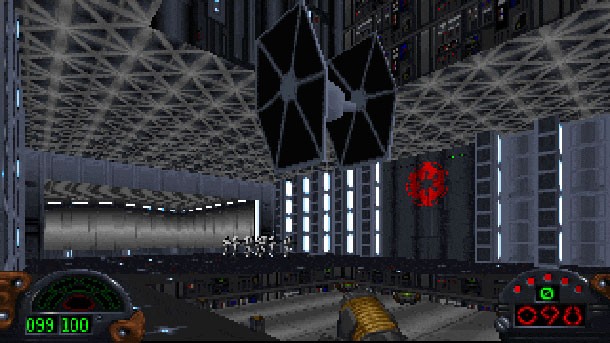
These new hires, along with the rest of the team, helped make Dark Forces much more than Doom with a glossy coat of Star Wars paint. Unlike other "Doom clones" of the era, Dark Forces transported Star Wars fans to a universe they always dreamed of inhabiting, and demonstrated the immersive potential of first-person shooters. Where the Doom series featured fast, frenetic gameplay set within dozens of abstract mazes, the locations of Dark Forces were designed with a form and function in mind. The vertical city of Nar Shaddaa features treacherous, vertigo-inducing catwalks, a brightly lit skyline, and crudely constructed polygonal ships floating through the air. A fully realized TIE fighter soars out of an Imperial hanger as the ground forces duke it out.

Former LucasArts developer and director of Dark Forces, Daron Stinnett
But if some called Dark Forces a "Doom clone," what did the fathers of the genre think of LucasArt's FPS achievement? "John Romero and Tom Hall [from id Software] contacted me and told me they loved the game, and so I invited them out to LucasArts for a tour and I took them up to the [Skywalker] Ranch and I had lunch with them there," Stinnett recalls. "George [Lucas] might have been there. We gave them the full tour of everything, and I still stay in contact with John."
Kudos from the developers that inspired Dark Forces' gameplay was great, but what about the creator of the universe himself? Stinnett remembers watching George Lucas play the game for the first time at a press event celebrating its release.
"I was pretty proud of what we'd made, and I was kind of waiting for him to be blown away," Stinnett says. "We had Stormtroopers and [Imperial officers], and we were shooting them, and he was not happy that we were shooting those guys. He said, 'You shouldn't have those guys in there because they're too human looking. There's a reason I made Stormtroopers, because I didn't want to feel like you're shooting other humans.' I was like, 'Really? That's the thing you have to say about the awesome game we made?' I was so destroyed. But then I showed him how to play it and he got into it, and by the time cameras got rolling he was running around and jumping over pits and shooting things and having good fun, at least for the cameras, I'll say."
Dark Forces may not have rocked Lucas to his core at the moment, but the PC original and PlayStation port made his company a sizeable chunk of credits. LucasArts sold more than 300,000 copies of the game at its 1995 launch, and nearly a million over the next five of its release. It also spawned the popular Jedi Knight series starting with its sequel, Star Wars: Jedi Knight – Dark Forces II. The series follows Katarn's path along the light side of The Force, featuring fun lightsaber combat, and introducing multiplayer.
While Dark Forces success for the purposes of LucasArts are unquestioned, it also elevated FPS game design to a new level.
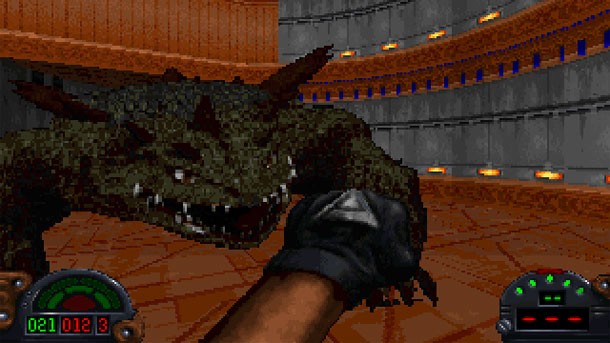
"I personally feel like we played a significant role in the genre, I don't think we did make a Doom clone," Stinnett says when asked how he feels about the game's legacy. "We went off and created something unique that people played for different reasons than people who played Doom. I think we pioneered and demonstrated the value of a lot of new aspects of the new 3D first-person shooter genre that you still see today."
Stinnett's pride and sense of partial ownership over the Star Wars brand extends beyond Dark Forces the other Star Wars titles he developed at LucasArts. He may no longer be working on any Star Wars projects (he's now co-founder of PlayGrid and CDRV Media), but he speaks like the franchise is still a part of him.
"At LucasArts, for many years, we really felt like we were guardians of the [Star Wars] brand," Stinnett says. "So, you can't help but feel a little bit of ownership over the brand, and to be critical of how people are treating the brand."
Filmmaker J.J. Abrams' long-awaited sequel to the beloved series, Star Wars: Episode VII – The Force Awakens, hits theaters this December, and Stinnett hopes the movie is good enough to make him forget he feels any professional investment in the franchise.
"If it's done well, a few minutes in the movie I'll forget my own involvement of the brand and simply watch it as an entertainment experience," he says. "Only if it's bad I think you would start to think about your own ownership and being critical about it, but I think everyone feels that way. I don't think that it's unique to me because I've worked from the Star Wars environment and LucasArts, I think everyone who is a fan of the fiction feels a sense of ownership towards how the brand is treated."
We'll have to wait until this winter to find out whether Abram's continuation of the George Lucas' uneven space epic will live up to Star Wars' legendary status, but Stinnett and the rest of LucasArts' contribution is set in carbonite. After 20 years, Dark Forces stands tall as an impactful and important innovator in the FPS genre, and one of the most impressive Star Wars games ever created.
To watch us play through and reminisce about Star Wars: Dark Forces, check out our episode of Replay commemorating the game's 20th anniversary.

